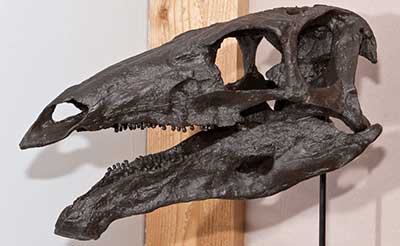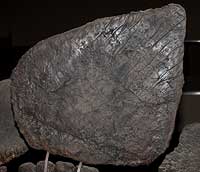Stegosaurus
(STEG-o-SAWR-us)
| Quick Facts | |
|---|---|
| Name Meaning: | Roof Lizard |
| Distribution: | Colorado, Utah, Wyoming, USA; Europe |
| Time Period: | Late Jurassic, 150 Ma |
| Length: | 30 ft. (9 m) |
| Height: | 9 ft (2.75 m) |
| Weight: | 2 tons |
| Diet: | Herbivore |
| Habitat: | Woodlands or Plains |
| Linnaean Classification | |
| Kingdom: | Animalia |
| Phylum: | Chordata |
| Class: | Reptilia |
| Superorder: | Dinosauria |
| Order: | Ornithischia |
| Suborder: | Thyreophora |
| Infraorder: | Stegosauria |
| Family: | Stegosauridae |
| Genus: | Stegosaurus |
| Cladistic Classification | |
| |

History
The Stegosaurus was first discovered in Colorado and named by Othniel Charles Marsh in 1877. Marsh originally thought that the plates discovered with the dinosaur had been lain flat across the dinosaurs back, hence the name. This theory was later discarded. He also thought that the Stegosaurus was bipedal, though he changed his mind in 1891 in favor of being quadrupedal due to the animals size and weight. So far only two well known species have been discovered with a third lesser-known species. Although originally discovered only in Western North America, recent discoveries have been made in Portugal, proving that the Stegosaurus had a wide range including Europe as well. The Stegosaurus is of the most popular dinosaurs in modern culture. It has been depicted in children's toys, media, and film, including King Kong (1933) and Steven Spielberg's The Lost World.Description

|
| Stegosaurus plate. |
Lifestyle
The Stegosaurus probably lived in the woods or plains feeding on low vegetation. It is possible that the Stegosaurus could have reached high plants by rearing on its hind legs. The tail would have been able to handle the stress this would have put on it because it was more flexible than the tails of most dinosaurs. Its narrow snout made it a selective eater and probably fed on soft shrubs. The use of the back plates is in some doubt. Although it may have been used as a defense by flapping them to one side or the other, this would not have provided much protection from a predator like the Allosaurus. The plates may have been used for thermal regulation by exposing sunlight to the blood vessels contained in the plates. It is likely that the plates were used as a display or a warning by flushing blood into them. The spikes on the tail were almost certainly used for defense especially considering the flexible nature of the tail. Also, an Allosaurus was uncovered with what appeared to be a puncture wound the size of a Stegosaurus spike. Due to discovered dinosaur tracks it is very likely that the Stegosaurus traveled in herds.
ScienceViews Writer: Jason Hamilton.
Copyright © 2005-2010 Calvin & Rosanna Hamilton. All rights reserved.